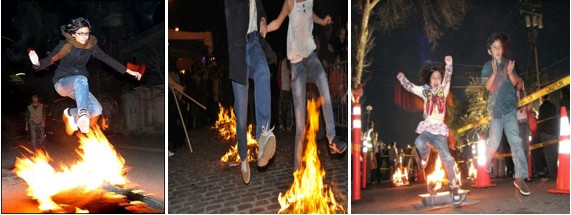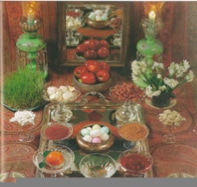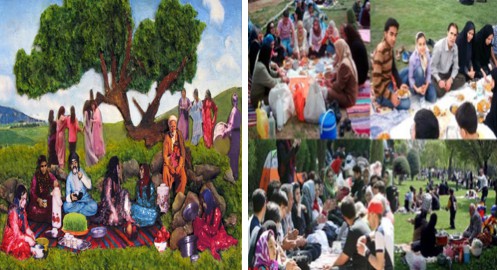March 20th, 2014

We are going to share the blog we posted in 2012 on the Persian/Iranian celebration of Now-Ruz with a few new additions.
Vernal Equinox
The celebration of Now-Ruz (New Day), takes effect at the exact astronomical beginning of Spring, known as the vernal equinox. Now-Ruz is celebrated today on March 20th and has been celebrated for nearly 3000 years by Iranians. It is an ancestral festivity marking the first day of spring and the renewal of nature. Its rituals and traditions date back to Zoroastrianism, the ancient Persian religion that existed until 7th century A.D. before the Arab invasion and the enforcement of Islam.
Nowruz: An official UN observance
The United Nations has proclaimed Nowruz an official UN observance because it promotes peace and solidarity, particularly in families. The day also focuses reconciliation and neighborliness, contributing to cultural diversity and friendship among peoples and different communities.
National Holiday
Now-Ruz celebrations last for 13 days. As a child growing up in Iran, Now-Ruz meant a school holiday lasting for 13 days. In fact, most businesses throughout the country would shut down for the duration of Now-Ruz. Everyone was on holiday!
Spring Cleaning
In preparation for Now-Ruz, Iranians embark on the spring-cleaning of their homes, even make or buy a new set of clothes (my brother and I loved getting a new outfit or two), and bake pastries in anticipation of visiting guests when gifts are exchanged and feasts enjoyed.
Chahar-Shanbeh Soori Fire Festival
The rituals surrounding the celebration of Now-Ruz are rich with symbolism and ceremony. They begin on the last Wednesday of winter with Chahar-Shanbeh Soori (Eve of Wednesday), a fire-jumping festival, where people create small bonfires in their neighborhoods and jump over them as the sun sets.

Celebrants taking a leap of faith during Chahar-Shanbeh Soori
Parents join in with their children and jump over the flames inviting happiness and abundance while releasing and letting go of darkness and negativity by chanting: “Offer me your lovely red hue and take away my sickly pallor.” With fire signifying light (day), the symbol of all that is good, and dark (night), the unknown and all that is evil, celebrants partaking in the fire festival look forward to the arrival of spring bringing longer days and new beginnings.
Minstrels, Troubadours and Mischief-making
As a child growing up in Iran, I remember the minstrels or troubadours, known as Haji Firuz, who sang and danced in the streets dressed in bright red and yellow satin poufy pants and shirts, spreading good cheer and bringing merriment to neighborhoods.

Boys and men in costumes as Haji Firuz
Another tradition, somewhat resembling the trick-or-treat of Halloween, included young men who disguised themselves as women under chadors (long veils) and went from street to street banging on pots and pans, shaking tambourines and raising raucous. All this was done in jest as seeing a boy or young man in such a disguise invited laughs and more laughs.
Haft-Seen Display

A major feature of Now-Ruz is the preparation of “Haft-Seen,” (seven “S’s”); a special display of seven specific offerings each beginning with the letter “S” in Farsi. Typically, the “Haft-Seen” includes the following: “seeb” or apple (promotes beauty and good health), “seer” or garlic (wards off bad omen), “samanou” (a sweet pudding, symbolizing affluence), “sabze” or wheat-germ (representing rebirth) grown in a flat dish a few days before the New Year, “sek-keh” or coin, preferably gold (for wealth and abundance), “senjed” (dried fruit from lotus tree, symbolizing love), and “somagh” or sumac (color of sunrise). In addition, there will also be a mirror (symbol for the sky), a goldfish in a bowl (life force), lit candles symbolizing fire and promoting enlightenment, colored eggs (symbol of fertility corresponding to the mother earth), sweets to spread sweetness and a book of poems by Hafiz or Rumi.
Sizdah Bedar (Out with the 13th) Festivities
The Now-Ruz festivities end on the 13th day known as “Sizdah Bedar” (out with the 13th), and it is celebrated outdoors. Staying indoors is seen as a bad omen and families spend the day outside in parks and in the countryside near streams, rivers, and lakes, enjoying a festive picnic. The “sabze” or plate of wheat-germ that was the centerpiece of the Haft-Seen is taken on this picnic so that young unmarried women wishing for a husband will tie a knot between the green shoots (symbolizing a marital bond) and toss it into running water.

Images of Sizdah-Bedar of the past and present
About 300 million people worldwide celebrate Nowruz, with traditions and rituals particularly strong in the Balkans, the Black Sea and Caspian Sea regions, the Caucasus, Central and South Asia, and the Middle East.
Despite Iran’s Islamic Republic’s attempts to do away with Now-Ruz, calling it un-Islamic and pagan, the ancient tradition of celebrating the arrival of Spring continues in Iran. Now-Ruz is a reminder that the darkness is fleeting: the day will soon be longer than the night; and with the arrival of a new day, change for the better, is in the near horizon.
Happy Now-Ruz!

Jasmin S. Kuehnert
President & CEO ACEI
www.acei1.com

Very Interesting, however “NOROOZ” is the correct spelling.